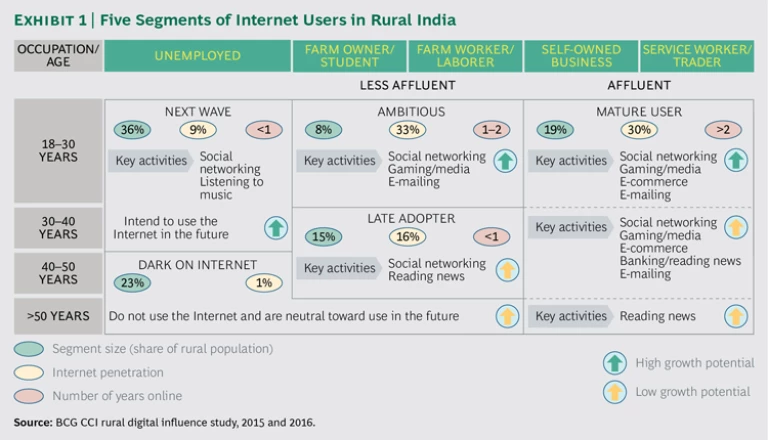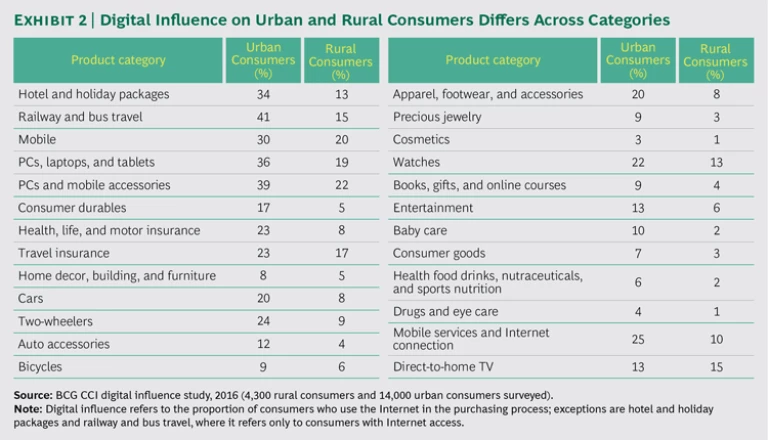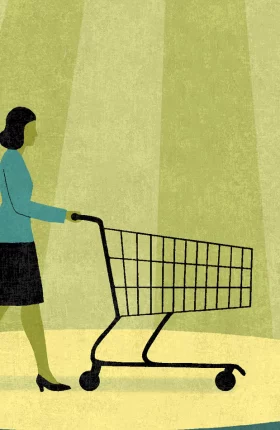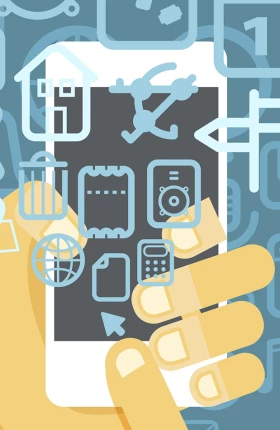Rapid growth in Internet usage in rural India is a double-barreled game-changer, with up to 300 million Indian consumers expected to be online by 2020. While most of the focus to date has been on urban users, rural areas—which are home to two-thirds of the country’s population, or some 870 million people—are where much of the action will be for the rest of the decade. We expect that more than half of all new Internet users will come from rural communities and that rural users will constitute about half of all Indian Internet users in 2020. Cheaper mobile handsets, the spread of wireless data networks, and evolving consumer behaviors and preferences will all drive rural penetration and usage. They will both change how rural consumers interact with companies and give companies many more options for engaging with rural consumers.
As we observed last year in our article on the changing digital consumer in India, new users of all kinds will approach the online experience with very different expectations, needs, priorities, and goals. (See “The Changing Connected Consumer in India,” BCG article, April 2015.) Understanding the changes taking place in Internet adoption and use in India and how these shifts will affect existing markets and ways of communicating—and create entirely new ones—is essential for anyone doing business in the world’s second-most-populous country, which is also soon to be the world’s second-largest nation of connected consumers.
This article looks at the changes taking place in India’s rural communities. Our observations and insights are based on surveys conducted by the Center for Customer Insight (CCI) of approximately 4,000 rural consumers in 27 villages in 14 states in 2015 and 2016. The objective of the surveys was to better understand the rural Internet user and the nature and extent of digital influence on his or her buying decisions.
Rural Connected Consumers: Who Are They?
We expect the number of connected rural consumers to increase from about 120 million in 2015 to almost 315 million in 2020, a jump of almost 30% a year. Rural growth will significantly outpace growth in urban centers, and by 2020, rural users will make up 48% of all connected consumers in India.
Rural Internet users are today almost exclusively male (98%), a different pattern from that of cities, where men dominate (79%) but women are also online in growing numbers (21%). More than 60% of rural users have been online for less than two years, which means most rural users are still relatively immature digitally, and their usage patterns can be expected to evolve as they gain experience.
It is a mistake to regard rural users as a single set, however. Even at this relatively early stage in their evolution, they can be categorized into five distinct segments that are of varying interest to marketers. (See Exhibit 1.)
Mature Users. The mature user is likely to be an 18- to 50-year-old (male) salaried worker or businessman from an affluent household. He has been online for three years or more, longer than people in any other segment. As a shopper, he is brand conscious, spends smartly, and actively trades up. His ownership of durable goods approaches that of urban dwellers. He accesses digital media daily and spends two to three hours online a day, primarily on a smartphone. There are some 160 million mature users (19% of the rural population), and Internet penetration is relatively high at 30%.
Ambitious Users. Internet penetration in this segment, which comprises around 8% of rural users, or almost 70 million people, is estimated at 33%. The typical ambitious user is a young male college graduate. He belongs to a less affluent household than the mature user and aspires to move to a city for work. An active consumer of digital media, he spends two to three hours daily online using an Internet-enabled phone (or, in some instances, a smartphone). Strong growth is expected of this segment.
Late Adopters. These are 30- to 50-year-old men who—though many own their own farms—are less affluent than their ambitious counterparts. They make up 15% of the rural population (125 million people), with 16% online penetration. Late adopters are savers and conservative consumers who trade up selectively and prefer value-for-money brands. They spend one to two hours a day online and primarily use entry-level smartphones. They access digital media four to five times a week.
Next-Wave Users. While this segment accounts for around 36% of rural users (almost 300 million people), Internet penetration is only around 9%. The typical member is a young female homemaker from an affluent household. Though not a college graduate, she is the decision maker in her household and prefers branded products. Next-wave users have generally just started going online, and they spend only about 15 minutes per day on the Internet using an Internet-enabled phone. Despite these users’ limited digital experience and maturity, the size and relative affluence of the segment make it one of three high-potential rural growth segments (along with the ambitious and mature segments).
Dark on the Internet. This segment, which makes up almost a quarter of the rural population, comprises older men and women (50 years and up) who do not work, are not well educated, and do not come from affluent households. They tend to have traditional values, and women in the segment do not play a role in family decision making. Household members share a basic phone. They have little interest in going online, and Internet penetration is only about 1%.
What Do They Do?
Almost 70% of rural users access social networks, which are their most popular online destination. But while urban users focus on the social aspect, interacting with friends on sites such as Facebook, people in rural areas use social networks to access the Internet, which is where their consumption of content—such as news and videos—primarily occurs. Other popular activities for rural consumers are downloading media (45%), searching for information (41%), and chatting and e-mailing (30% each).
Rural users’ online behavior varies by segment. Ambitious users play games, download media, and are especially active on social networks. The online activities of next-wave users are more limited: interacting on social networks and listening to music. Late adopters are mainly social networkers, while mature users seek out business and job information, read news, and play games.
Online use evolves as users become more digitally mature. For mature users, the ability to interact with and influence peers is paramount, but as they spend more time online, all users gravitate toward consuming more content. (See the sidebar “A Mature User’s Internet Journey (So Far).”)
A MATURE USER’S INTERNET JOURNEY (SO FAR)
“I started using the Internet when I was in college, four years back. I used a Nokia E63 and a Web browser for search. Now I own a Samsung Galaxy Grand smartphone and I have about ten apps for games, Facebook, Whatsapp, and shopping.”
Vikas is only 26, but with four years of online experience, he is more than mature by the standards of India’s rural Internet users. Vikas lives in Haryana, where he runs a medical supply shop. His journey to Internet maturity is typical of rural consumers in India’s mature-user segment.
Vikas is a trend follower; he keeps himself updated on the latest technology. Once he started online, he was quick to appreciate the benefits of social media and online search, even though he was using a feature phone with limited capability. Now he replaces his smartphone about every two years in order to have the latest technology. Online information and retailers influence his purchase decisions. Over the years, as Vikas has learned more about apps and digital content, he has upgraded data packs in order to get faster access to more Web options. His online spending has increased from about 150 rupees a month four years ago to about 350 rupees today. His usage has expanded from basic search and music downloads to watching videos, shopping and banking online, and accessing online job portals.
The time that Vikas spends online has risen steadily from about 30 minutes a day to more than two hours a day. He appreciates the benefits of the Internet, citing convenience, exchange of knowledge, and the ability to get the latest news and sports updates, play games, and watch videos.
Internet penetration and usage in rural India vary by geography. Two southern states, Kerala and Tamil Nadu, and four northern states—Himachal Pradesh, Haryana, Punjab, and Jammu and Kashmir—have the highest penetration. Kerala at 37%, Himachal Pradesh at 28%, and Punjab at 27% top the chart. Many eastern states, such as Bihar (9%), Odisha (10%), West Bengal (11%), and Assam (12%), are at the lower end of the spectrum. Usage patterns vary quite starkly. Users from the north and south use online video and voice calling to stay in touch with family members, many of whom live outside of India. In the south, where literacy rates are higher, online job portals and education-related search activities are popular.
Key Differences Between Urban and Rural Users
There are significant differences between rural and urban Internet users that marketers need to take into account.
Primarily for reasons of cost and network availability, almost two-thirds of rural users go online using inexpensive Internet-enabled phones (also known as feature phones) connected to 2G or sometimes 3G networks. Only about a quarter of these users have smartphones and only 10% use PCs or laptops. In urban areas, by contrast, almost two-thirds of users own smartphones, and another 20% use PCs or laptops. Rural usage patterns will change over time as device prices drop and faster networks are deployed. But in the near term, the experience for the vast majority of rural users will remain fundamentally different from that of their urban counterparts—the users for whom companies have so far been developing digital marketing strategies and campaigns.
Because of the differences in device and network capability, rural and urban users use different apps for similar activities. For example, rural users are more likely to use the UC Web browser (which is popular in other emerging markets as well) because it employs technologies such as data compression, which helps load Web content faster and reduce data consumption during browsing. They tend to use apps such as SongsPK, which downloads songs for free, because streaming does not work well on 2G connections. For messaging, many rural residents use Whatsapp, which was probably one of the first apps they tried. Alternatives such as Hi and Line are perceived to be heavy data consumption apps; they are used more for video calls and exchanging files. Vernacular media consumption apps such as Dailyhunt (formerly NewsHunt) and Dainik Jagran are more popular than English apps such as The Times of India.
Even when rural users use the same app as urban consumers, they often use it for different purposes. Take Facebook, which is a go-to app for millions. In cities, Facebook is all about staying in touch with friends and making use of its social features, such as photo and video sharing, while in rural areas, it is often the only app on the phone and therefore the main way to access news and videos. Rural users are much less likely than urban users to be interactive social media participants, who upload lots of content themselves.
Digital’s Expanding Influence on Rural Commerce
The influence of the Internet on the purchasing process is already becoming a significant factor in rural areas. Almost 15% of rural consumers use the Internet to research products, purchase a product, or register satisfaction or dissatisfaction with a product after the purchase is made, compared with 30% of urban consumers. Moreover, among Internet users, the degree of digital influence is as high in rural areas as it is in cities. Today, the purchases of four out of five rural Internet users are digitally influenced, which suggests that as Internet penetration rises in rural areas, so will the influence of digital.
The amount of actual online commerce in rural India is still small, but it is picking up. From 2015 to 2016, the penetration of online purchasing in these areas doubled from 4% to 8%. Convenience and discounts are the key reasons that rural consumers buy online—63% and 62%, respectively, cite these factors. Product availability is an important factor for 40%.
The degree of digital influence and actual online purchasing differs across categories. In several product categories, including mobile devices, PCs, and laptops, the Internet’s influence in rural areas is approaching the same level as in cities. In other categories, such as consumer durables, autos, apparel, and entertainment, it is still far behind. (See Exhibit 2.)
Implications for Companies
In 2015 we observed that under the right circumstances, India’s Internet economy could triple in size to $200 billion by 2020. A big part of that growth will come from rural markets as the number of connected consumers climbs toward 300 million. Companies will need to build comprehensive digital strategies, which will have to take rural markets, and their distinctive attributes, into account. Marketers looking to target rural consumers in India should consider the following actions.
- Develop a segmented view of the rural market. Not all rural consumers are the same—or even alike. As noted above, there are five different segments, each at its own level of digital adoption. Similarly, there are stark differences in the level of digital influence across various product categories. Companies looking to tap the rural market should first evaluate which touch points in their targeted customers’ purchase journeys are most affected by digital and to what extent.
- Rethink the cost of serving rural markets. The economics of the Internet give marketers an opportunity to reevaluate the business case for reaching rural markets. In other developing markets, such as China, companies have built entirely new models to serve rural customers. (See the sidebar “Alibaba Moves E-commerce into the Countryside.”)
- Adapt the online experience for rural users. Websites and apps designed with urban consumers in mind may not be effective in rural markets, where device screens are smaller and connections are slower. Content must fit on feature phones and work with low-data apps and connections. There is a strong need for vernacular content as well.
- Refocus advertising budgets. Even today in rural markets, the Internet rivals TV as a source of influence. Rural consumers spend about 40% of their total media time on digital media—the same as urban consumers—although they have different reasons for preferring digital channels, including the ability to tap into the latest media content at low cost, receive constant updates, and gain access to vernacular and geographically diverse classified content. For all consumers, the number of hours spent on digital media increases with experience and maturity. We expect more media companies to create digital destinations with vernacular content that cuts across genres (such as news, sports, gossip, and Bollywood), which will appeal especially to rural consumers. (See “Digital Disruption in India’s Media Industry: Who Will Win?” BCG infographic, April 2015.) Marketers should think beyond conventional channels when it comes to advertising for rural consumers.
- Bring down the barriers to online sales. While there has been an upward trajectory in rural online buying, the number of e-commerce buyers in rural areas is still small. Factors related to delivery and returns are big issues, but there is also a widespread perception in the countryside that e-commerce is neither safe nor reliable. Almost 40% of rural consumers feel that their personal information is at risk, while 30% believe that products sold online are of poor quality and 25% find e-commerce sites and apps hard to use. On the other hand, rural consumers who have made online purchases cite multiple benefits, including discounts, ease of shopping, speed and convenience, and variety. Marketers can help overcome existing barriers with tools and promotions that increase awareness and use, which eventually will lead to purchasing and loyalty among rural online shoppers.
ALIBABA MOVES E-COMMERCE INTO THE COUNTRYSIDE
China’s e-commerce colossus, Alibaba, provides a model for how companies can think about using digital channels to bring e-commerce to rural markets in a large and diverse developing country.
In October 2014, Alibaba announced it was investing $1.6 billion to set up 100,000 rural service centers all over China’s countryside. It has a presence in almost 16,000 villages so far. These e-commerce outposts are equipped with computers and free Internet service. The centers give villagers a place to pick up the goods they buy online from Alibaba. They can also pay their utility bills, add credit to their prepaid mobile phone plans, and book travel at these centers. Service managers are available to help first-time shoppers.
In addition, the company’s “rural partners” program tasks Internet-savvy young people who live in cities but often return to their home villages with helping people learn to buy—and sell—online. Some villagers have used the service centers to start their own online businesses—selling clothes made in nearby factories on Taobao, Alibaba’s eBay-like online marketplace, for example.
The company’s rural expansion program is credited with helping fuel Alibaba’s continued overall growth.
Rural Internet use in India is rising. New users will come online, and current users will expand both their time online and the activities they pursue as they gain digital maturity. Online commerce is in its infancy in rural markets but is increasing fast. Digital is already a significant influence on purchasing. India’s marketers need to take all these factors into account and plan now for a big and growing rural digital marketplace.
Acknowledgments
The authors are grateful to Indira Ghagare for her assistance in developing this report.







